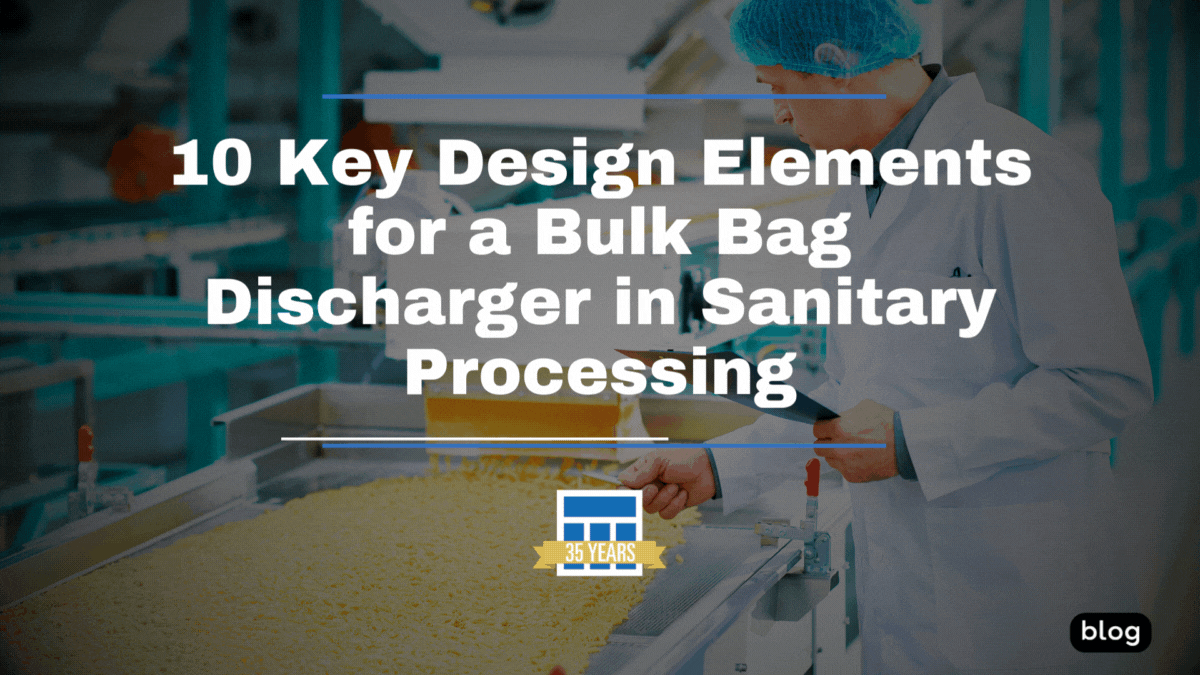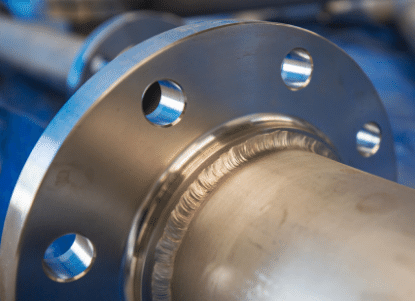
Designing processing equipment, such as bulk bag dischargers, for sanitary environments that demand exceptional cleanliness and structural strength requires specific design considerations and high-quality finishes. These standard design elements are not just details—they are game-changers that can dramatically enhance the efficiency and hygiene of your operations.
Here are the 10 design elements to consider when implementing a bulk bag discharger in a sanitary environment:
1. Frame Design: Horizontal Tube Configuration
All horizontal tubes within the framework should be constructed using round or square tubes oriented at a 45° angle to form a “diamond pattern.” This deliberate design improves the structure’s visual appeal and simplifies the cleaning process. Avoiding flat surfaces minimizes debris build-up, contributing to more sanitary conditions on the production floor.
2. Avoiding Penetrations in Structural Tubing
Structural tubing should not be penetrated in order to maintain the integrity and strength of the frame. This practice helps prevent weak points that could compromise the structure’s durability and cleanliness. Penetration can also create a potential site for contamination, and this design aims to avoid contamination risk during the bulk bag unloading process.

3. Continuous External Welds
All external structural welds must be continuous and as laid, with no porosity allowed. This ensures a robust and reliable structure. Any gaps or porosity in the welds can lead to contamination and weaken the frame. To do this, the discharging system is fabricated using clean and dry welding surfaces. Proper shielding gases are also used to prevent atmospheric gases from entering the weld pool.
4. Ground and Smooth Product Contact Welds
All welds in product contact zones should be ground smooth and flush with the mating surface. This practice eliminates crevices where bacteria and debris could accumulate, ensuring a more sanitary environment.
5. Stainless Steel Standards
The use of stainless steel throughout the structure of a super sack unloader addresses strict food safety guidelines in food processing facilities. The material is known for its corrosion resistance and durability, making it ideal for maintaining high hygiene standards. The smooth finish of stainless steel also minimizes the risk of contamination and makes the surfaces easier to clean.
Continuous TIG Welding: Ensure all structural welding is continuous TIG with no porosity allowed, and welds are passivated.
Surface Finish: Stainless steel surfaces that come into contact with products should have a .8 micron (32 microinches) Ra finish.
Material Standard: All components in the product zone (all food contact surfaces) should be made from 304 stainless steel.
Pneumatic Tubing: All rigid pneumatic tubing should be made from stainless steel with stainless steel fittings.
Electrical Conduits: Similarly, all rigid electrical conduits and conduit fittings should be made of stainless steel.
6. Solid Body Stand-offs for Component Mounting
All components should be mounted on solid body stand-offs. This design facilitates easy cleaning and ensures that components are securely attached to the frame without compromising hygiene.
7. Tool-Free Removable Product Zone Components
Providing tool-free removable components in the product zone can greatly enhance the ease of maintenance and cleaning. This feature allows for quick disassembly and reassembly, saving time and reducing downtime.
8. Solenoid Valve Enclosures
Solenoid valves should be housed inside enclosures with a view window. This design protects the valves from external contaminants while allowing easy monitoring and cleaning.
9. Tented Hoist Monorail Top
The hoist and trolley monorail can be tented to reduce dust accumulation. This design helps in maintaining a clean environment by preventing the buildup of dust and debris on critical components.
10. Dust-Tight Operational Components
Eliminating airborne dust particles during bulk bag unloading is critical. Material Transfer offers 3 levels of dust control of bulk materials on our unloader systems. Level one includes the Sure Seal™️ Spout Clamping System is a safe and operator-friendly solution designed to pneumatically clamp the bulk bag spout between a flange ring and an inlet stub, forming a dust-tight seal. The Seal Master® Chamber offers the 2nd level of containment which features gullwing doors with compression seal when in the closed, secure position. The 3rd level available is an integrated dust collection system.
By following these guidelines, you can design a frame that is not only structurally sound but also easy to clean and maintain, ensuring high standards of hygiene and efficiency in operations. The Team at Material Transfer offers decades of application experience to deliver a sanitary design custom-built to meet your unique process requirements. Contact us today to learn more!
FAQs
What are the specific benefits of using a diamond-patterned tube configuration compared to other designs?
The specific benefits of using a diamond-patterned tube configuration compared to other designs include enhanced structural aesthetics and simplified cleaning. The diamond pattern created by orienting square tubes at a 45° angle reduces the accumulation of debris, making it easier to maintain sanitary conditions. This design is particularly advantageous in environments where cleanliness is critical, as it minimizes flat surfaces where dust and contaminants can settle.
How often should the tool-free removable components in the product zone be inspected or replaced to maintain optimal hygiene?
Tool-free removable components in the product zone should be inspected regularly, ideally during routine maintenance checks, to ensure they remain in optimal condition. The frequency of inspection and replacement depends on the usage intensity and the specific sanitary requirements of the processing environment. Regular inspections help identify wear and tear or any potential contamination risks, ensuring that the equipment maintains high hygiene standards and operates efficiently.
What are the potential consequences of not using dust-tight operational components in bulk bag dischargers?

